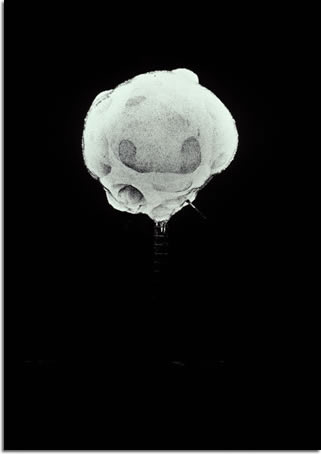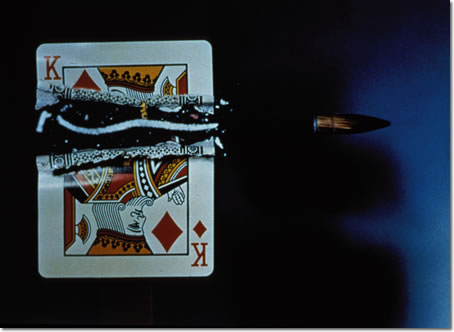|
Week IV: Photography Until Now-1/17
I. Post War Directions
A. The Age of Science/The Age of Anxiety

Harold E. Edgerton, Atomic Bomb Explosion, 1952.
11 x 14 inches.
Collection Middlebury College Museum of Art, Gift of Richard F. Young,
1988.112.
In my opinion, one of the most sobering photographs
in the Museum collection is Harold E. Edgerton's photograph of an atomic
bomb test, taken in 1952. Edgerton captured the very early moment of
the blast, before the mushroom cloud took shape. The image is a hauntingly
beautiful one, yet full of the portent of unleashed power.
Edgerton was well-known for his ability to capture split
seconds of time in his photographs. A physicist at MIT, Edgerton perfected
the use of strobe lights for photography, eventually producing exposure
times in the millionths of a second. The Middlebury Museum of Art is
fortunate to have a rich collection of Edgerton's work illustrating
his amazing ability to stop time.

Harold E. Edgerton, Cutting the Card Quickly,
dye transfer print, 1964. Collection Middlebury College Museum of Art,
Gift of Richard F. Young.
Cutting the Card Quickly, done in 1964, is a
good example of the lighter side of his work. Here, without any manipulation,
we see a bullet stopped in space after it has bisected the King of Diamonds.
Today with Adobe Photoshop and other ways of digitally manipulating
photographs, this could be done artificially. For Edgerton, it was a
tour-de-force of lighting, timing, and perseverance.
But the atomic bomb photograph is a different kind of
image. It calls to mind the sense of foreboding that hung in the air
after the end of the war and that was expressed in existential philosophy
and literature. This same sense of anxiety and loss was also expressed
in photography.
|